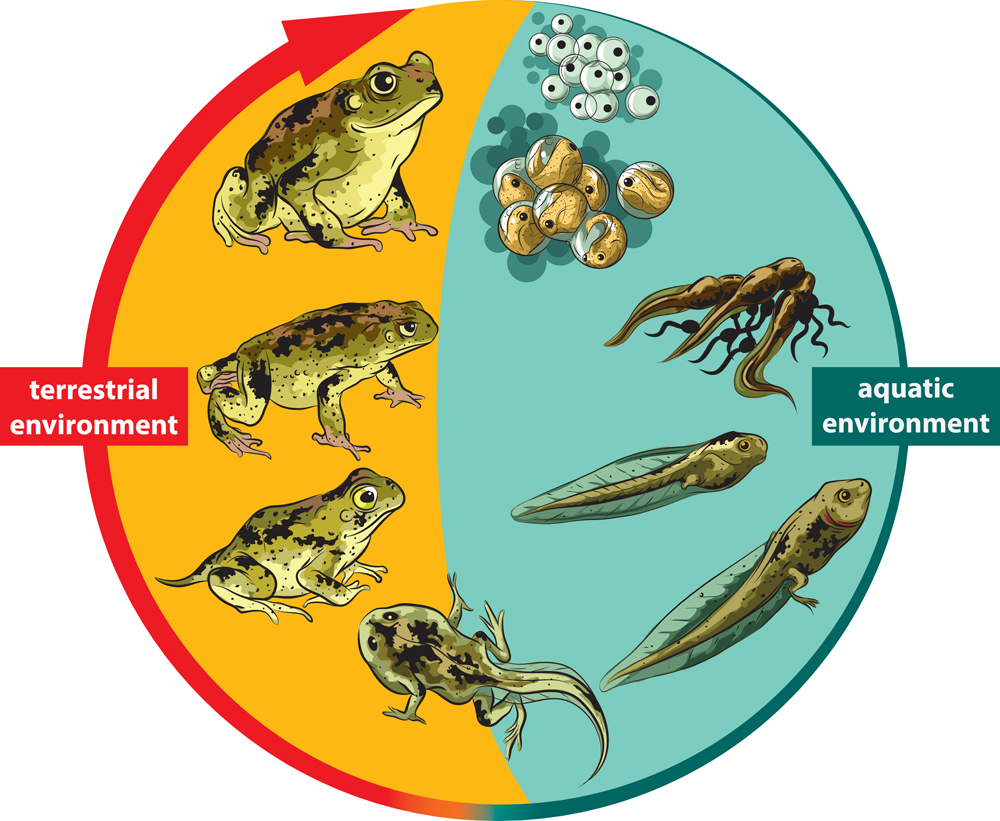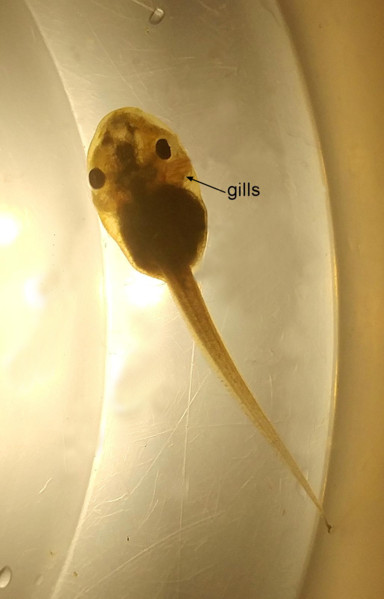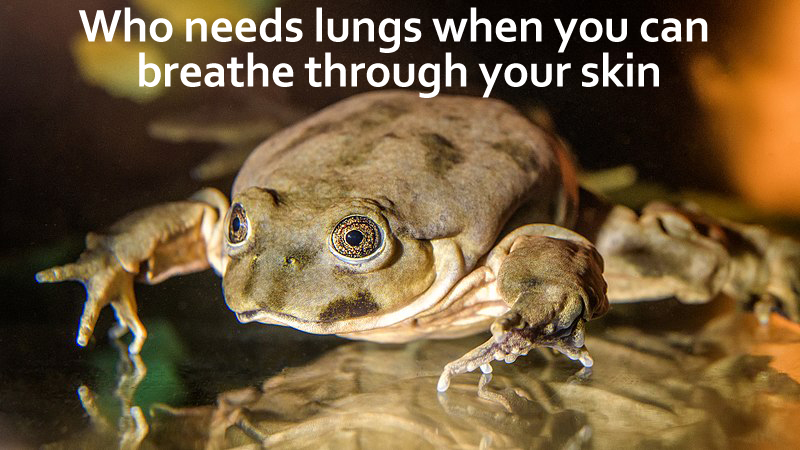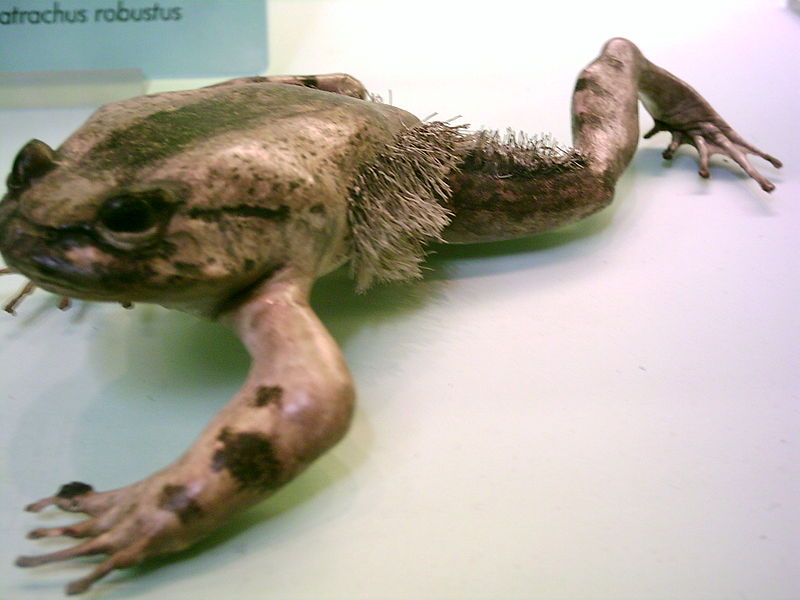Frog larvae, also known as tadpoles, breathe through gills, as they are aquatic. As tadpoles metamorphose into adult frogs, they begin to breathe through lungs. The lungs of frogs aren’t well-developed, so frogs also breathe through their skin.
A frog’s croaking may be annoying, but to counteract its aesthetically ugly voice, it has one of the most fascinating abilities in the animal world—frogs breathe through both their lungs and skin. Not only that, frogs actually change how they breathe as they mature from a baby frog to a mature adult frog!
Frogs Are Amphibians
The name amphibian comes from the Greek word amphibios, which means ‘a being with a double life’. Their “double life” refers to the fact that amphibians can coexist between living on land and living in water.
The frog, like its other amphibians cousins, such as toads and salamanders, begins life in the water. The female frog will lay her soft transparent eggs in the water (unless you’re a Surinam toad). Out of the eggs will come baby frogs! However, the baby frogs, or tadpoles, look nothing like their parents.
They have an alien sperm-like appearance with a large flat oval head that tapers into a tail. For the first few weeks of its life, the tadpole swims around eating algae and aquatic plants, building its reserves for when it will begin its transformation into an adult.
This transformation, called metamorphosis, will happen over many weeks, wherein the sperm-like tadpole will undergo a host of physiological changes, growing in size, developing four legs, and slowly retracting its tail.
These changes will make the frog eligible to make the land its permanent abode.

Unfortunately for the frog, air and water don’t facilitate breathing in quite the same way. This means that the frog must also adapt its breathing accordingly to its new life.
Also Read: Can Fish Walk On Land?
Tadpoles Breathe Through Gills
Tadpoles have gills that allow them to breathe during their underwater phase of life. The gills, which are usually covered with a flap of skin, are located on the side of their head.

Along with gills, the tadpoles also develop lungs. These lungs help the tadpole breathe in water with a low oxygen concentration. To breathe air, tadpoles must come up to the surface and poke their heads out of the water. However, a tadpole is too small to break the surface tension of water. So the tadpole must instead come up near the surface of the water and suck in air bubbles.
Also Read: Can Fish Live (Or At Least Breathe) In Liquids Besides Water?
Adult Frogs Can Breathe Through Their Lungs
The tadpoles ditch their gills eventually, developing a new pair of lungs to adapt to their life on land. That said, adult frogs lungs don’t work like human lungs.
Frogs don’t have a ribcage nor a diaphragm, two body parts that help mammalians change the pressure inside their lungs and facilitate breathing. Instead of expanding their chests and breathing in air, the frog gulps in air.
To take in air, a frog will expand its throat by lowering the bottom of its mouth. Air rushes into the expanded mouth cavity through the nostrils. Then the frog simply gulps that air into its lungs by contracting the bottom of its mouth. When the frog breathes out, the whole process happens in reverse, pushing air from its lungs into its mouth and then out into the world!

Though frogs have lungs, they aren’t well developed enough to do the job by themselves. So, to meet all their oxygen needs, frogs have one more ingenious mode of breathing up their sleeves.
Frogs Can Breathe Through Their Skin
The frog’s skin, believe it or not, picks up the slack for the lungs.
To exchange gases, the frog’s skin is thin and smooth. Thick and tough skin with scales, feathers, or fur would impede, rather than aid, gaseous exchange. Interestingly, some frogs can change the thickness of their skin in response to the concentration of oxygen in water. The less oxygen in the water, the thinner their skin was found to be.
If you’ve ever had the displeasure of touching a frog, you know that they are quite slimy. This slime is a mixture of mucous and proteins that helps keep the frog’s skin moisturized, as dry skin doesn’t allow for effective skin breathing.
Capillaries beneath the skin take in the oxygen and supply it to tissues close by.
For some frogs, skin breathing can be so efficient, that they primarily or, in some instances, solely rely on it.
Take the Titicaca water frog, for example. This underwater frog solely breathes through its skin. It has numerous skin folds that increase the creature’s surface area, thus allowing more gaseous exchange. In fact, the frog often performs underwater push-ups to ensure that water reaches all its many skin folds.

Another example is the hairy and slightly scary Astylosternus robustus. This hairy frog’s skin is heavily penetrated with capillaries for skin breathing. With reduced lung size and capacity, the hairy frog doesn’t have much of an option other than skin breathing.

This becomes a concern when the male frogs embark on their very elaborate and energy-consuming mating ritual.
To make sure it doesn’t run out of breath, a male frog will create additional folds in its skin. This action makes it look like the frog has erupted hundreds of gruesome moles on its back, so it’s a good thing the females don’t care much about traditional beauty!
A Final Word
If you think about it, it’s remarkable that one animal can breathe through its gills, its lungs, and its skin—all in the same lifetime. We frequently think that breathing is performed by a separate breathing organ—gills for fish, trachea for insects, or lungs for humans—but for the frog, breathing is a far more dynamic and flexible process!
How well do you understand the article above!

References (click to expand)
- Frog Respiration. Brown University
- Skin Breathing in Vertebrates - Scientific American. Scientific American
- Noble, G. K. (1925, June). The integumentary, pulmonary, and cardiac modifications correlated with increased cutaneous respiration in the amphibia: A solution of the ?hairy frog? problem. Journal of Morphology. Wiley.
- Schwenk, K., & Phillips, J. R. (2020, February 19). Circumventing surface tension: tadpoles suck bubbles to breathe air. Proceedings of the Royal Society B: Biological Sciences. The Royal Society.
